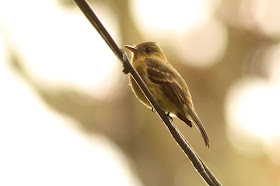Black-billed Nightengale-thrushes are common highland birds. Note the (for once appropriately named) bill, the similar ruddy-capped (coming soon to a post near you) had a bicolored bill
A Tufted Flycatcher teed up on an overhead power line as we walked out to a field where quetzals had been feeding earlier in the morning.
Our guide Vernon was fairly excited about the near side-to-side comparison with a very hard-to-find highland endemic that flew in 20 yards farther down the line, an Ochraceous Pewee
The Ochraceous is heavier-bodied, heavier-headed, slightly less crested, and less warmly colored than the similar Tufted Fly. Last year our guides worked and worked for an Ochraceous on the Los Robles trail that they could hear calling up in the canopy before we finally got scope looks, this year it came straight to us.
The Costa Rican version of Hairy Woodpecker was also very ochraceous (and with a lot less white in the wings). My understanding is that they have a continuous clinal transition, but skipping south 2000 miles made a big difference in appearance.
Each of the volcanoes in Costa Rica has Volcano Hummingbirds with a slightly different throat color. In the Talamanca highlands it's a dull lavender. When they were all split this one was called "Heliotrope-throated."
Finally a lifer, a Yellow-billed Cacique, a loose cousin to orioles but one that skulks in the underbrush
Don't ask me to pronounce it though.
Oh and the quetzals? They might be deserving of their own post...







No comments:
Post a Comment